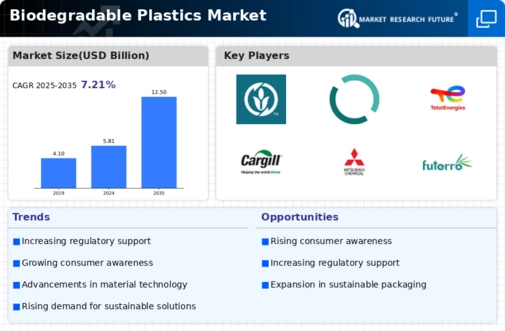The Biodegradable Plastics Market is witnessing significant growth as environmental concerns continue to rise and demand for sustainable materials increases. This market is characterized by a diverse range of companies that are innovating to provide eco-friendly alternatives to conventional plastics.
Various players are focusing on the development of biodegradable materials made from renewable resources, emphasizing reduced environmental impact and compliance with stringent regulations.
Competitive dynamics in this space include not only product offerings but also the adaptation to consumer preferences and the establishment of strategic partnerships that enhance distribution and market reach.
As the market evolves, companies are also leveraging advancements in technology to improve product performance and reduce production costs, solidifying their positions against competitors.
Tianjin GreenBio Materials has established a strong presence in the Biodegradable Plastics Market by innovating in the production of eco-friendly materials derived from renewable sources.
The company boasts strengths such as advanced manufacturing processes and a commitment to research and development, enabling it to create high-quality biodegradable plastics that meet the diverse needs of various industries.
Its focus on sustainable practices positions Tianjin GreenBio Materials favorably as consumers increasingly demand products that contribute positively to environmental sustainability.
The company has also invested in expanding its operational capabilities and enhancing product offerings, allowing it to maintain a competitive edge in a rapidly evolving market landscape.
Moreover, its strategic collaborations and partnerships further bolster its market presence by facilitating wider distribution networks and improved customer engagement.
NatureWorks operates as a leading player in the Biodegradable Plastics Market, particularly noted for its innovations in producing Ingeo biopolymer, a high-performance biodegradable plastic made from renewable resources.
This differentiation has allowed NatureWorks to capture significant market share by appealing to industries seeking sustainable packaging solutions.
The company emphasizes its commitment to sustainability and circular economy principles, which resonate well with environmentally conscious consumers and businesses alike.
NatureWorks has also made notable strides in forming strategic alliances and partnerships, enhancing its capabilities through mergers and acquisitions that broaden its technological base and accelerate product development.
The key services offered by NatureWorks reflect a comprehensive approach to product solutions, focusing on both functionality and environmental friendliness, thereby solidifying its status as a prominent player in the global market for biodegradable plastics.





















Leave a Comment